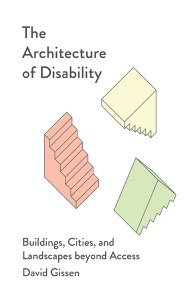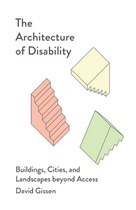The Architecture of Disability
Buildings, Cities, and Landscapes beyond Access
David Gissen

By recontextualizing the history of architecture through the discourse of disability, this book presents a unique challenge to current modes of architectural practice, theory, and education. Envisioning an architectural design that fully integrates disabled persons into its production, it advocates for looking beyond traditional notions of accessibility and shows how certain incapacities can help to positively reimagine the roots of architecture.
This book is an urgent and exhilarating manifesto that calls for nothing less than a complete rethinking of architecture. Rather than insisting that architectural forms need to be adjusted to accommodate a greater diversity of impairments, it uses diversities of physical, mental, social, and collective capacities to unlock new ways to conceive of architecture, model it, design it, describe it, represent it, theorize it, and write histories about it. The fictional singular, athletic, male, young, healthy, undamaged, untraumatized, white body at the center of normative architectural discourse finally gives way to a permanently complex philosophical and political agency reshaping the way buildings are thought.
Beatriz Colomina, author of X-Ray Architecture
Disability critiques of architecture usually emphasize the need for modification and increased access, but The Architecture of Disability calls for a radical reorientation of this perspective by situating experiences of impairment as a new foundation for the built environment. With its provocative proposal for “the construction of disability,” this book fundamentally reconsiders how we conceive of and experience disability in our world.
Stressing the connection between architectural form and the capacities of the human body, David Gissen demonstrates how disability haunts the history and practice of architecture. Examining various historic sites, landscape designs, and urban spaces, he deconstructs the prevailing functionalist approach to accommodating disabled people in architecture and instead asserts that physical capacity is essential to the conception of all designed space.
By recontextualizing the history of architecture through the discourse of disability, The Architecture of Disability presents a unique challenge to current modes of architectural practice, theory, and education. Envisioning an architectural design that fully integrates disabled persons into its production, it advocates for looking beyond traditional notions of accessibility and shows how certain incapacities can offer us the means to positively reimagine the roots of architecture.
Cover alt text: Black title text on all-white background. At center, three simply drawn staircases in orange, yellow, and green, from different perspectives.
$24.95 paper ISBN 978-1-5179-1250-5
$100.00 cloth ISBN 978-1-5179-1249-9
216 pages, 26 b&w photos, 5 1/2 x 8 1/2, January 2023

A disabled designer and historian of architecture, David Gissen is professor of architecture and urban history at Parsons School of Design at the New School.

This book is an urgent and exhilarating manifesto that calls for nothing less than a complete rethinking of architecture. Rather than insisting that architectural forms need to be adjusted to accommodate a greater diversity of impairments, it uses diversities of physical, mental, social, and collective capacities to unlock new ways to conceive of architecture, model it, design it, describe it, represent it, theorize it, and write histories about it. The fictional singular, athletic, male, young, healthy, undamaged, untraumatized, white body at the center of normative architectural discourse finally gives way to a permanently complex philosophical and political agency reshaping the way buildings are thought.
Beatriz Colomina, author of X-Ray Architecture
The Architecture of Disability takes a historically rich, theoretically informed route beyond disability access as a functional problem in architecture (and one often poorly resolved). Reading familiar sites such as the Parthenon alongside lesser-known landscapes of walking, rolling, and embodied presence, David Gissen centers disabled perspectives—including his own—to reveal new theoretical avenues to and poetic journeys through the built world.
Bess Williamson, author of Accessible America: A History of Disability and Design
By placing disability at the heart of the built environment, Gissen provides a radical critique of architecture while conceiving of a new way of experiencing disability.
Metropolis
The piece pays attention to disability that has previously been poorly understood in the field of architecture, building an architecture of disability.
Finnish Architectural Review
This book builds on Gissen’s transformative contributions to the discipline with a combination of erudition and accessibility.
Constructs, Yale Architecture
Part manifesto and part memoir, Gissen’s book upends centuries’ worth of dogmatic thinking in architecture by inserting ‘impaired’ and ‘disabled’ bodies into focus, an overdue act, as they have been excluded by the Western canon with very few exceptions to date.
The Architect’s Newspaper
Gissen brings a nuanced critique of the design professions.
The Globe and Mail
It is rare to read a book that relates as deeply to the way you have both lived and thought for the length of your life as this one does for me—and even rarer that it helps you imagine the future of your own thought, too. . . In The Architecture of Disability, author, designer, and educator David Gissen manages to dismantle and reconstruct the world through the combined strength of his own experience and a critical perspective on the material world and its many under acknowledged histories.
Jordan Whitewood-Neal, Winterthur Portfolio
The Architecture of Disability is a poignant call to arms to address the omnipresence of ableism across a broad spectrum of environments.
Architectural Record
The Architecture of Disability uses the lens of disability to reevaluate received architectural histories and speculate on a more inclusive architectural environment, one divested from the inherited biases around function and form.
The New York Review of Architecture
Designers at all scales can take in this slim volume as a set of concepts for reinvigorating their work by productive defamiliarization. For practitioners, Gissen offers ways to see differently, to think differently, and therefore to practice differently.
Landscape Architecture Magazine
Gissen’s thoughtful engagement with theory and history alike clearly demonstrates deficits in the field, outlining how ableism bleeds into just about every practice and principle.
H-Net Reviews

Contents
Introduction: From Accessible Design to an Architecture of Disability
1. Impaired Monuments: Architecture, History, and the Preservation of Disability
2. Of a Weaker Nature: Wilderness, Urban Landscapes, and Biocapacity
3. The Urbanization of Disability
4. A Form of Impairment: Empathy and Disfigurement in Architectural Aesthetics
5. Disabling Environments: Human Physiology and Its Architectural Conditions
6. The Construction of Disability: Another Architectural Theory of Tectonics
Coda: The Practice of Disability
Acknowledgments
Notes
Index













